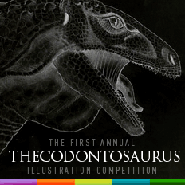Discovered in 1834 near Bristol Zoo, Clifton, the Bristol dinosaur was only the 4th dinosaur ever discovered in the world. Ideas about what the dinosaur looked like are changing all the time as paleontologists find out more about its bones which are held at the University and Bristol Museum & Art Gallery.
With some helpful tips and clues online, children and adults are invited to draw their own version of the Bristol dinosaur. Winners will be announced in late spring and displayed at the museum during the summer. The winning pieces will be used to show people what the dinosaur looked like through the project’s public engagement programme.
People can find out about what to do and how to submit their artwork here.
Ed Drewitt, Learning Officer for the Bristol Dinosaur Project, said: “We want as many people in the UK to draw the West’s very own dinosaur. This a great opportunity for children and adults alike to find out more about the Thecodontosaurus and make their mark on science.”
Ray Barnett, Head of Collections at Bristol Museum & Art Gallery, said: “Thousands of people visit our museum and see the real bones of Bristol’s very own dinosaur. The competition is a chance for our visitors to have their own say on what it may have looked like 210 million years ago.”
The Bristol Dinosaur Project
The Bristol Dinosaur Project has been funded through the University of Bristol since 1999 with both a focus on preparing fossils from the Bristol Dinosaur and promoting it through schools, family events and festivals. The project is based in the School of Earth Sciences and currently has a grant of almost £300,000 from the Heritage Lottery Fund. More information can be found at bristoldinosaur.com.
The Bristol Dinosaur
The Bristol dinosaur's scientific name, Thecodontosaurus antiquus, means ‘ancient socket toothed reptile’. It lived around 210 million years ago on warm, tropical islands around Bristol – part of a group of small islands known as the Mendip Archipelago – a little like the Caribbean or the Seychelles today.
Thecodontosaurus was a small dinosaur, 2.5 metres long – about the size of a medium size dog such as a Labrador with a long tail. It had powerful back legs and smaller front legs. It walked around on all fours but reached up into the trees with its front legs, using its claws to grab hold of the stems of prehistoric trees known as cycads. It had small sharp teeth, each with tiny sharp bumps running along one side which made the teeth more like knives, able to tear through thick, juicy leaves. Thecodontosaurus lived in small groups known as herds, with the male animals being larger than the females.
Bristol Museum & Art Gallery
Bristol Museum & Art Gallery is part of Bristol’s Museum, Galleries and Archives which includes the new M-Shed Museum, Blaise Castle House Museum, the Red Lodge, the Georgian House, Kings Weston Roman Villa and the Archives Service.
The real bones of the Thecodontosaurus can be seen for free at Bristol’s new museum, M-Shed down by Bristol’s Harbourside and the first floor of Bristol Museum & Art Gallery.
